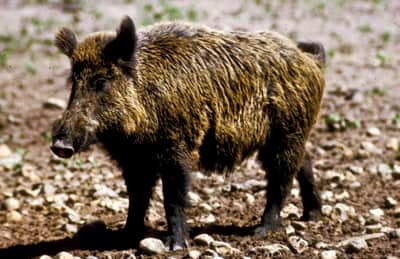Texas to Pay Sportsmen to Hunt Hogs
OutdoorHub Reporters 06.20.13

There are an estimated five million feral pigs in the United States, half of which are located in the Lone Star State. Texas already spends $7 million on their hog management programs but experts say that is not enough to prevent the population from tripling in the next five years. To keep the pigs under control, the state will have to eliminate nearly 66 percent of the swine every year. For comparison, hunters and trappers accounted for over 750,000 pigs harvested in 2010, only 29 percent of the population.
However, Texas does have a few cards up its sleeve, and the foremost of these is boasting one of the largest and most dedicated hunting cultures in America. Hunting hogs has not only become a Texas tradition, but now a necessity.
Many hunters bemoan the fact that while hogs are undoubtedly detrimental to the land, many landowners still charge a fee for hunting on their property. With the addition of equipment and ammunition, these hunts can become very pricey. Now the state is offering an extra incentive in the form of bounties. The Texas Department of Agriculture (TDA) will be partnering with county governments to launch the 2013 County Hog Abatement Matching Program (CHAMP). The initiative will encourage counties to match state funding dollar-for-dollar up to $30,000, which will be then paid to hunters.
In order to receive state funds county governments will have to apply for the program by July 1. The Cove Herald reports that several counties have already signed up for CHAMP including Milam, Falls, Bell, and Hamilton counties.
Feral pigs can be destructive enough on land, but the animals are also having a significant impact on the state’s waterways. In the Leon River Watershed alone there are an estimated 26,000 pigs. Their destructive behavior and fecal matter pushed the watershed into the “impaired” rating by the Environmental Protection Agency. The abundance of bacteria introduced by the pigs is also affecting native wildlife and flora.
“One of the biggest things I can do to control the feral hog impact is to help the counties get more funding for feral hog abatement,” said Mike Marshall, coordinator for the Leon River Watershed.
Hogs are also found on farms, golf courses, and residential areas in every one of the state’s 254 counties. The animals have caused an estimated $500 million in damages. Part of the reason for their success is how adaptable pigs are in the wild. Capable of producing one-and-a-half litters per year, pigs are growing far faster than they can be destroyed.
“The feral hog population has exploded in the last 20 years, and our ability to control them will depend on two primary factors,” TDA Commissioner Todd Staples told the Southwest Farm Press. “First, our efforts must be coordinated across all public entities and private landowners. Second, we must focus on the most low-cost, high-return methods when investing limited taxpayer dollars into this effort.”
In 2010 the department created the Hog Out Challenge that encouraged hunters to harvest pigs, leading to a high number of pigs removed. Texas is once again looking for a similar low-cost, results-producing strategy.
“This is both an urban and rural problem that directly impacts our economy and the future of Texas agriculture,” Staples added. “We need to step up our efforts to thwart these dangerous creatures, and CHAMP does just that.”

